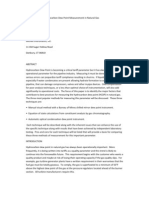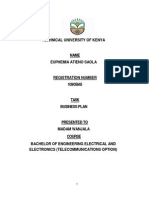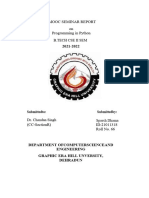Gas Chromatography Analysis Speeds LPG Distillation: Analytical Instrumentation
Gas Chromatography Analysis Speeds LPG Distillation: Analytical Instrumentation
Uploaded by
Carolina OñateCopyright:
Available Formats
Gas Chromatography Analysis Speeds LPG Distillation: Analytical Instrumentation
Gas Chromatography Analysis Speeds LPG Distillation: Analytical Instrumentation
Uploaded by
Carolina OñateOriginal Description:
Original Title
Copyright
Available Formats
Share this document
Did you find this document useful?
Is this content inappropriate?
Copyright:
Available Formats
Gas Chromatography Analysis Speeds LPG Distillation: Analytical Instrumentation
Gas Chromatography Analysis Speeds LPG Distillation: Analytical Instrumentation
Uploaded by
Carolina OñateCopyright:
Available Formats
16
Analytical Instrumentation
Focus on Gas Chromatography
Gas Chromatography Analysis
Speeds LPG Distillation
Ciro Pendino, Logistics Department Head, Tamoil SA,
Collombey Refinery, 1868 Collombey, Switzerland.
Tel: +41 24 4756258
Email: cpendino@tamoil.com
www.tamoil.com
Euroweg 2, 3825 HD Amersfoort, The Netherlands.
Tel: +31 88 464 1210
Email: Norbert.zeug@de.yokogawa.com
www.yokogawa.com/eu
Dr. Norbert Zeug, Business Development Manager, Analytical Business Europe Yokogawa Europe BV
This article describes the efficiency improvements that have resulted from automating the analytical instrumentation in the liquefied
petroleum gas (LPG) columns at the Tamoil refinery in Collombey, Switzerland.
Since the 1960s, the Tamoil SA refinery in the Western
part of Switzerland has been processing crude oil and
semi-finished products, which arrive by pipeline from
Genoa, Italy, into a wide range of finished products
including gasoline, diesel and aviation fuel, various
types of heating oil and liquid gas both as both fuel for
vehicles and as raw material for the petrochemical
industry. The current capacity of the refinery amounts to
approximately 2.5 million tons per year or 7200 tons per
day, representing about one-fifth of Switzerlands total
fuel demand. In the course of the last 15 years this site,
which employs more than 200 workers, has continually
been modernised and expanded in order to cater for
changed market requirements and to further improve
production efficiency, particularly in the area of energy
consumption.
LPG distillation
At approximately only three percent, liquefied
petroleum gas (LPG) constitutes a relatively small share
of the production of the refinery in Collombey.
Nevertheless, this light fraction, which consists mostly of
saturated hydrocarbons with three and four carbon
atoms (i.e. propane and butane), has substantial
significance for the process control of the entire refinery.
That is because of the fact that these low boiling-point
components are used in different ways:
On the one hand, they are sold as fuel for gaspowered vehicles. Because the higher boilingpoint fractions of the LPG (C5+ fraction) can be
sold more profitably in gasoline while at the same
time the maximum permitted concentration of the
C5+ fraction in liquid gas for vehicles is limited,
Tamoil limits this fractions share in LPG to a
maximum of 2.5%.
On the other hand, the C4 proportion of the LPG
is added in the blending process to the gasoline in
different quantities depending on the season and
according to the fuel specifications. In summer, the
proportion can only be relatively small the internal specification lies within less than 1%, so
that the vapour pressure of the fuel does not
exceed the maximum permissible 60 kPa, as
opposed to the winter, when this limit is 90 kPa and
accordingly a higher C4 proportion of up to 25%
gives an economic advantage in so far as the
respective octane number requirements are to be
brought into alignment with it.
LPG is essentially separated in Collombey in three
places in the production process (Fig.1): during the
naphtha stabilisation, during the reforming stabilisation
after the catalytic reforming, and after the hydrotreatment of the light gas oil. The heavy fraction of the
latter separation is fed back into the atmospheric
distillation, so that an extensive separation of the LPG
has direct energy savings and thus economic benefits
as the amount of recirculated mixture decreases.
Optimal LPG separation is further complicated by
the fact that its proportion and composition are also
subject to fluctuations. These fluctuations arise firstly from
October/November 2009
adaptation of a reliable analysis model that must be
specifically provided for the individual separation
problem. These aspects would have certainly delayed
the implementation of an appropriate solution, as well
as increasing the costs.
Measuring close to the process
Figure 1: Simplified representation of the material flow in
the Collombey refinery
the differing quality of the crude oil, secondly from
different ambient temperatures (during daytime and
night-time, for example) and thirdly from different hydro
treatment assets. In total, more than 400 m3 of liquid gas
are produced per day in Collombey.
Faster analysis leads to better separation
The demand for a more efficient operating mode for
the separating columns can only be fulfilled if more
precise information can be obtained about the
composition of the light fraction: something that
previously involved evaporation samples in the
laboratory. More significantly, however, it needs
measurement values to be available at a substantially
higher frequency than is possible with manual
sampling followed by laboratory analysis: a process
that previously allowed not more than two analyses per
day to be made for each column. In addition, only the
products of naphtha stabilisation can be analysed using
the evaporation procedure because the other product
flows contain dissolved hydrogen sulphide, meaning
that laboratory analysis can only be carried out under
substantial safety conditions.
Crucial to the successful implementation of a GC
process analysis in the separating columns was an
analysis which could be performed as close to real time
as possible, i.e. an almost delay-free sampling and a
short analysis time in order to reflect the situation in the
process immediately. This can be achieved most
economically when the analysers are positioned in
direct proximity to the columns. Feeding the product to
a centrally positioned analyser shelter would involve
long stainless-steel pipes and correspondingly high flow
rates in order to obtain close to real-time results.
In addition, there is also the danger of condensation,
which would lead to analysis errors.
Furthermore, because of the lage drop in pressure
over the long sampling lines, it would be difficult to feed
the product back into the process. It would therefore
have to be fed back into the flare, which would entail
unnecessarily high product losses. It is much easier to
install an analysis unit with sample evaporator and
sample conditioning system just a few metres away from
the column.
The liquid gas flow from the process is first
connected by a small-volume fast loop to the sample
evaporator. The gas then flows a short distance to the
heated sample conditioning system, and is finally fed to
the gas chromatograph. This minimal fast loop concept
has several advantages, including the near real-time
access to precise information about the process,
coupled with simple and robust installation.
At the beginning of the instrumentation project, it
was therefore important to select a state-of-the-art,
robust and - on the basis of the total cost of ownership attractive solution for the LPG analysis. Between
the two concepts considered first: namely, NIR
spectroscopy and the process gas chromatography
(GC) - the decision fell in favour of the GC solution in
initial discussions with Yokogawa, a company which was
also finally selected as the system partner. The main
factor that counted against an NIR solution was that it
could only be used without problems in a homogeneous
liquid phase. Since with a liquid/gas mixture close to its
boiling-point curve, the occurrence of vapour bubbles
has always to be taken into account, the reliability of
this alternative appeared to be endangered right from
the beginning.
Furthermore, an NIR concentration determination of
hydrocarbons with rather similar chemical and
spectroscopic properties initially requires extensive
preparatory work, such as the development and
Figure 2: The Yokogawa Model GC 1000 Mark II process
gas chromatograph
Focus on Gas Chromatography
The sophisticated GC analyser (Fig.2) offers an
important advantage, especially for decentralised use:
it does not need air conditioning, but only heating and
ventilation. The equipment, furnished with a packed
column and a thermal conductivity detector, works on
the back-flush principle in order (depending on the
exact requirements of the process) to determine in
the shortest possible time the most crucial parameter:
in this case, the C5+ proportion in the LPG. To this end, as
complete as possible separation of the C3 and C4
components is carried out before back flushing.
The comparison with suitable test mixtures then permits
the quantitative determination of the total of the
higher boiling-point components. Moderate fluctuations
in the composition of the C5+ fraction have little
effect on the accuracy of the measurements because
of the very similar thermal conductivities of the
hydrocarbons involved.
These analysis units were installed on all three LPG
columns. The exact position as well as the individual
arrangement of the sample supply was done in
consultation with the system partner and one of its
authorised local installation partners. The installation of
the sampling equipment and the analyser cabinets was
carried out as part of a planned plant shutdown in
summer 2007, and the measuring points were gradually
put into operation in August and September 2007.
No difficulties arose, and the systems have worked very
reliably from the start.
value is available for the C5+ concentration at each of
the measuring points every 150 seconds - around the
clock. These values form a substantially more reliable
and more precise basis for the subsequent statistical
computations for the characterisation of the distillation
process, and have resulted in a substantial increase in
quality. It is now possible to react automatically with a
total delay of barely 15 minutes by adjusting the column
feed and other distillation parameters to changes in the
composition of the LPG fraction.
Figure 3: Top-level functional overview of the three GC
analysis systems in Collombey
connected via the Tamoil intranet (Fig.4), so that data
exchange over the intranet closes the information loop.
Because of the relatively large distances between the
analysers and the maintenance stations (approximately
150 m each), it was decided to use fibre-optic data
communications. Using the intranet in this way saved
the substantial costs of a several hundred metres long
glass fibre connecting directly to the measuring point.
The maintenance network uses a special data
concept in which the maintenance information from
the three analysers is first fed to two separate stations
The new analysis equipment has proven to be
particularly successfully in the column, which is
downstream of the hydro-treatment stage. Here the
LPG fraction contains a considerable amount of C3
hydrocarbons, such as propane, and the efficiency of
the separation has now been increased to the extent
that between 1.5 and 2 m3/h more LPG is produced
than before the installation of the process analysis
equipment. Among other things, the quantity of off
gas is also reduced. The sales value of the additionally
product, as well as the energy savings from the reduced
feedback into the atmospheric distillation - contribute
to a substantial overall saving.
Summary
Integrated monitoring and maintenance
concept
Although the individual measuring points in the plant are
separated by several hundred metres from one another,
they can be simply and easily controlled and supervised
from a central analyser server (Fig.3). Here the current
status of each measuring point is shown at any time.
In addition, detailed status reports can be called up,
chromatograms displayed and calibration procedures
initiated and monitored. In winter - especially in bad
weather - this is an important advantage. Only the
replacement of empty feed gas bottles and calibration
media now has to be carried out on the analyser
cabinets themselves.
Analytical Instrumentation
Figure 4: Integrated transmission concept for
maintenance information for the process GCs at the
LPG columns
Closed-loop control for more efficiency
The crucial objective of the automation of the LPG
column analysis was to significantly increase the
efficiency of the process. Within a few months of startup, it was clear that this expectation was confirmed.
With the automated system, an accurate measured
The project for the analytical upgrade of the LPG
columns at the Tamoil refinery in Collombey with
Yokogawas process GCs has been a complete
success. Clear responsibilities and short response times
led to the fact that barely a year separated the
first tender and commissioning. The choice of a
worldwide experienced system supplier, who was
responsible for the project from the design of an
optimally suitable solution to the planning, engineering,
installation and start-up up to the training of the workers,
has proved itself to be an optimal solution for Tamoil.
This is particularly important because the project
required a high level of process understanding and
therefore needed a competent project manager. In this
way, potential additional workload for the refinery
personnel has been avoided.
All systems have functioned since start-up without
problems and have fully met expectations. This also
applies for the connection to the distributed control
system and the monitoring of the analysers by means of
fibre-optic data communications.
October/November 2009
17
You might also like
- API Technical Data BookDocument1,316 pagesAPI Technical Data BookSofi Perez MuñozNo ratings yet
- Cor Vision PlusDocument224 pagesCor Vision PlusAndrei Ivanov67% (3)
- Floor Plan ManagerDocument14 pagesFloor Plan Managersapafj100% (1)
- Lesson 1-The Formation of The UniverseDocument41 pagesLesson 1-The Formation of The UniverseRaymond Escuzar100% (2)
- DragonDocument10 pagesDragonCristina Amariutei100% (7)
- Emcee Script JsDocument10 pagesEmcee Script JsRon Styx88% (24)
- Liquefied Gas Conversion Chart: AcetyleneDocument7 pagesLiquefied Gas Conversion Chart: Acetylene1224adh100% (1)
- hb156 2012final PDFDocument80 pageshb156 2012final PDFJesika Andilia Setya WardaniNo ratings yet
- R CalculationDocument17 pagesR CalculationAee TrDNo ratings yet
- Shell GTL N Paraffins c10 c13 Revision1Document4 pagesShell GTL N Paraffins c10 c13 Revision1Rohith KommuNo ratings yet
- Gas Data TablesDocument79 pagesGas Data TablesAmrane AhalimNo ratings yet
- VLE CalculationDocument8 pagesVLE CalculationDa SaintNo ratings yet
- Pure Component DataDocument15 pagesPure Component DataBayu AjipNo ratings yet
- SettingsDocument3,328 pagesSettingseimanoNo ratings yet
- Unit Conversions Between U.S. Customary System & Metric SystemDocument1 pageUnit Conversions Between U.S. Customary System & Metric SystemMario Sajulga Dela CuadraNo ratings yet
- Gas Properties: Molecular WeightDocument2 pagesGas Properties: Molecular WeightDamar WibisonoNo ratings yet
- Cargo HandlingDocument5 pagesCargo HandlingWibowo ArieNo ratings yet
- Diethylene Glycol Cargo Handling SheetDocument7 pagesDiethylene Glycol Cargo Handling SheettoanvmpetrologxNo ratings yet
- GAS QUALITY Methane Number Calculation 2012-04-04Document4 pagesGAS QUALITY Methane Number Calculation 2012-04-04Gabriel BerrioNo ratings yet
- Gas Properties: Molecular WeightDocument2 pagesGas Properties: Molecular WeightDamar WibisonoNo ratings yet
- API STANDARD 5.6 PresentationDocument24 pagesAPI STANDARD 5.6 PresentationfarhanNo ratings yet
- GPA Table of Physical PropertiesDocument15 pagesGPA Table of Physical PropertiesMiissaEll Garciia100% (1)
- Nitrogen DataDocument8 pagesNitrogen DatanitrovertNo ratings yet
- IEA HeadlineEnergyDataDocument837 pagesIEA HeadlineEnergyDataMarco Navarro RodriguezNo ratings yet
- Fire and Explosion of LPG TankDocument14 pagesFire and Explosion of LPG TankRhama WijayaNo ratings yet
- Sweet Crude CompositionDocument278 pagesSweet Crude Compositionthermo_engineerNo ratings yet
- Sampling: - Representativity of The SampleDocument14 pagesSampling: - Representativity of The Samplemangesh.narkar638No ratings yet
- Workbook Contents: U.S. Natural Gas Pipeline ProjectsDocument9 pagesWorkbook Contents: U.S. Natural Gas Pipeline ProjectsAli fouratiNo ratings yet
- L P G Part 1-Safety-LPG Short Course-5-05-Rev1Document18 pagesL P G Part 1-Safety-LPG Short Course-5-05-Rev1liveconnectionz282No ratings yet
- CO2 Baseline Database For The Indian Power Sector.Document41 pagesCO2 Baseline Database For The Indian Power Sector.Pooja Jain100% (1)
- Lewis Mathesons MethodDocument20 pagesLewis Mathesons MethodprudhvifireNo ratings yet
- Gas Physical PropertiesDocument139 pagesGas Physical PropertiesYusuf RiadiNo ratings yet
- Henry's Law ConstantDocument9 pagesHenry's Law ConstantSiLan SubramaniamNo ratings yet
- Gpa 2174 - 93Document15 pagesGpa 2174 - 93jairo7662No ratings yet
- APCI Process Analysis and OptimizationDocument10 pagesAPCI Process Analysis and OptimizationKunal KhandelwalNo ratings yet
- Volume of Compressed Gas in A CylinderDocument2 pagesVolume of Compressed Gas in A CylinderWaleed EmaraNo ratings yet
- Ullage LPGC PG2Document2 pagesUllage LPGC PG2asep supriyadiNo ratings yet
- Excel Work Book For Heat ExchangersDocument88 pagesExcel Work Book For Heat ExchangersHedi temimiNo ratings yet
- Antoine Coefficient CalculationDocument8 pagesAntoine Coefficient CalculationAditiya Muhammad FattahNo ratings yet
- VCF For LPG 200 POINTS If SP - Gravity at 15 C or 23 CDocument40 pagesVCF For LPG 200 POINTS If SP - Gravity at 15 C or 23 Cتامر دندشNo ratings yet
- 2022 Anhydrous Ammonia Code of Practice July 2021Document121 pages2022 Anhydrous Ammonia Code of Practice July 2021Hasbi Fatih Azizy100% (1)
- CNG Specs - Iso 15403Document20 pagesCNG Specs - Iso 15403Shasahank JoshiNo ratings yet
- COSTALD Correlation For Saturated Liquid DensitiesDocument3 pagesCOSTALD Correlation For Saturated Liquid DensitiesPrasad patgaonkarNo ratings yet
- Japan's First LNG SatelliteDocument13 pagesJapan's First LNG SatellitethawdarNo ratings yet
- Ecole Sigtto QuestionareDocument18 pagesEcole Sigtto QuestionareImmorthalNo ratings yet
- Mole CalculationDocument19 pagesMole CalculationWilliamNo ratings yet
- Carbon Dioxide CaptureDocument8 pagesCarbon Dioxide Capturedarenft_No ratings yet
- Ammonia NH3 Safety Data SheetDocument9 pagesAmmonia NH3 Safety Data SheetShafiraNabillaAl-HabsyNo ratings yet
- Gpa Standard 2145 09Document4 pagesGpa Standard 2145 09xjaf01No ratings yet
- GPA Standard 2174-93Document15 pagesGPA Standard 2174-93marcosNo ratings yet
- Manual Iata UnDocument34 pagesManual Iata UnMarlon Martinez CNo ratings yet
- On LPGDocument24 pagesOn LPGShreya Saransh GoelNo ratings yet
- BSA Creat Clearance Calculation OriginalDocument2 pagesBSA Creat Clearance Calculation Originalstrider_sdNo ratings yet
- Iso 6976Document1 pageIso 6976Waleed El-azabNo ratings yet
- NKK GuideDocument62 pagesNKK GuideElias KarvounisNo ratings yet
- Gas Transportation Storage I 2018Document52 pagesGas Transportation Storage I 2018Johny ImitazNo ratings yet
- 2013 Report Alternative FuelsDocument78 pages2013 Report Alternative Fuelsscorpion2001gla100% (1)
- ASTM TablesDocument460 pagesASTM TablesAbhishek PandeyNo ratings yet
- Thermal Billing Using Calorific Values Provided by Pipeline SimulationDocument10 pagesThermal Billing Using Calorific Values Provided by Pipeline SimulationBinarga SatriaNo ratings yet
- Determination of Hydrocarbon Dew Point Measurement in Natural GasDocument13 pagesDetermination of Hydrocarbon Dew Point Measurement in Natural GasgabowinerNo ratings yet
- 4 - Report On Gas Analysis in Cement Plant PDFDocument77 pages4 - Report On Gas Analysis in Cement Plant PDFTin Nguyen0% (2)
- Hydrocarbon Dewpoint DeterminDocument8 pagesHydrocarbon Dewpoint Determineng20072007No ratings yet
- 32 Productivity Increase in A PeirceSmith Convert 153013Document14 pages32 Productivity Increase in A PeirceSmith Convert 153013amirlpNo ratings yet
- Claudia Bassano, Paolo Deiana, Giuseppe Girardi: HighlightsDocument11 pagesClaudia Bassano, Paolo Deiana, Giuseppe Girardi: HighlightsSorrawit TantipalakulNo ratings yet
- Electromagnetic Compatibility by Felicito S Caluyo PDFDocument40 pagesElectromagnetic Compatibility by Felicito S Caluyo PDFmjpadz100% (2)
- Camden Fashion: Video UK - Exercises: PreparationDocument2 pagesCamden Fashion: Video UK - Exercises: PreparationVeronika SrncováNo ratings yet
- RCD AssignmentDocument3 pagesRCD AssignmentArj AsisNo ratings yet
- Satellite Communications System Design: Presented To: Engr. Vincent Ronquillo Presented By: Group 3Document13 pagesSatellite Communications System Design: Presented To: Engr. Vincent Ronquillo Presented By: Group 3Caleb BañaresNo ratings yet
- LPJ PPDB 2018/2019: SMK Insan TazakkaDocument2 pagesLPJ PPDB 2018/2019: SMK Insan TazakkaSMK INSAN TAZAKKANo ratings yet
- (Iii) "Class C Fire" - Fire Arising Out of Gaseous SubstancesDocument2 pages(Iii) "Class C Fire" - Fire Arising Out of Gaseous SubstancestulasiraoNo ratings yet
- 0620 Example Candidate Responses Paper 5Document26 pages0620 Example Candidate Responses Paper 5Hidayah TeacherNo ratings yet
- Analisis Kuantitatif Sediaan Obat DGN SpektrofluorometriDocument71 pagesAnalisis Kuantitatif Sediaan Obat DGN SpektrofluorometrideeNo ratings yet
- Trends and Practices in Financial Planning in Pune:The Curious Case of Yadnya Investment ServiceDocument51 pagesTrends and Practices in Financial Planning in Pune:The Curious Case of Yadnya Investment ServiceAli SaifyNo ratings yet
- Suy Sing Offerings 2021 WSDocument2 pagesSuy Sing Offerings 2021 WSJayvee BayaniNo ratings yet
- Tomba Et Al-2018-Journal of Raman SpectrosDocument11 pagesTomba Et Al-2018-Journal of Raman SpectrosDaniel MontalvoNo ratings yet
- 963Document50 pages963nanilNo ratings yet
- Surface Diagnostics in TribologyDocument13 pagesSurface Diagnostics in TribologyDersein SaraozNo ratings yet
- Business PlanDocument36 pagesBusiness PlanArun NarayananNo ratings yet
- Ref. No. 257, S. 2019 - Submission of Participants To The Division Teacher Induction Program (TIP) 2019 PDFDocument17 pagesRef. No. 257, S. 2019 - Submission of Participants To The Division Teacher Induction Program (TIP) 2019 PDFChristine SalientesNo ratings yet
- 5.5 KW Diesel DC GeneratorDocument5 pages5.5 KW Diesel DC GeneratorCoordinador RanMauNo ratings yet
- Image To Caption GeneratorDocument7 pagesImage To Caption GeneratorIJRASETPublicationsNo ratings yet
- 24 A - Review - On - The - Effect - of - Soil - Compaction - and - ItsDocument23 pages24 A - Review - On - The - Effect - of - Soil - Compaction - and - ItsLiv CBNo ratings yet
- Phrasal Verbs - GrammarDocument24 pagesPhrasal Verbs - GrammarRosalba Bryan100% (2)
- Mooc ReportDocument16 pagesMooc ReportSparsh DhamaNo ratings yet
- Print NumericalDocument23 pagesPrint Numericalsreekantha reddyNo ratings yet
- Mona Lisa Bonbon Cups RecipeDocument11 pagesMona Lisa Bonbon Cups RecipeAhmad AlayanNo ratings yet
- Gait TrainingDocument46 pagesGait TrainingCulan CuLinNo ratings yet
- Spencer Green Pathways PlannerDocument2 pagesSpencer Green Pathways PlannerspencerxgreenNo ratings yet
- EMPYEMADocument27 pagesEMPYEMAMark Bin S. DilangalenNo ratings yet

























































































